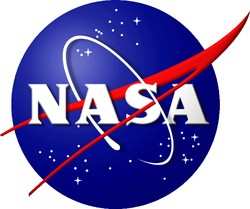Meteorites Deliver Diverse Genetic Material To Earth
 NASA-funded researchers have found
more evidence meteorites can carry DNA components created in space.
Scientists have detected the building blocks of DNA in meteorites
since the 1960s, but were unsure whether they were created in space
or resulted from contamination by terrestrial life. The latest
research indicates certain nucleobases -- the building blocks of
our genetic material -- reach the Earth on meteorites in greater
diversity and quantity than previously thought.
NASA-funded researchers have found
more evidence meteorites can carry DNA components created in space.
Scientists have detected the building blocks of DNA in meteorites
since the 1960s, but were unsure whether they were created in space
or resulted from contamination by terrestrial life. The latest
research indicates certain nucleobases -- the building blocks of
our genetic material -- reach the Earth on meteorites in greater
diversity and quantity than previously thought.
The discovery adds to a growing body of evidence that the
chemistry inside asteroids and comets is capable of making building
blocks of essential biological molecules. Previously, scientists
found amino acids in samples of comet Wild 2 from NASA’s
Stardust mission and in various carbon-rich meteorites. Amino acids
are used to make proteins, the workhorse molecules of life.
Proteins are used in everything from structures such as hair to
enzymes, which are the catalysts that speed up or regulate chemical
reactions.
The findings will be published in the online edition of the
Proceedings of the National Academy of Sciences. In the new work,
scientists analyzed samples of 12 carbon-rich meteorites, nine of
which were recovered from Antarctica. The team found adenine and
guanine, which are components of DNA nucleobases.
Also, in two of the meteorites, the team discovered for the
first time trace amounts of three molecules related to nucleobases
that almost never are used in biology. These nucleobase-related
molecules, called nucleobase analogs, provide the first evidence
that the compounds in the meteorites came from space and not
terrestrial contamination.
"You would not expect to see these nucleobase analogs if
contamination from terrestrial life was the source, because they're
not used in biology," said Michael Callahan, astrobiologist and
lead author of the paper from NASA's Goddard Space Flight Center in
Greenbelt, Md. "However, if asteroids are behaving like chemical
'factories' cranking out prebiotic material, you would expect them
to produce many variants of nucleobases, not just the biological
ones, because of the wide variety of ingredients and conditions in
each asteroid."
Additional evidence came from research to further rule out the
possibility of terrestrial contamination as a source of these
molecules. The team analyzed an eight-kilogram (21.4-pound) sample
of ice from Antarctica, where most of the meteorites in the study
were found. The amounts of nucleobases found in the ice were much
lower than in the meteorites. More significantly, none of the
nucleobase analogs were detected in the ice sample. The team also
analyzed a soil sample collected near one of the non-Antarctic
meteorite’s fall site. As with the ice sample, the soil
sample had none of the nucleobase analog molecules present in the
meteorite.
Launched in Feb. 7, 1999, Stardust flew past an asteroid and
traveled halfway to Jupiter to collect particle samples from the
comet Wild 2. The spacecraft returned to Earth's vicinity to drop
off a sample-return capsule on January 15, 2006.
The research was funded by NASA’s Astrobiology Institute
at the agency’s Ames Research Laboratory in Moffett Field
Calif., and the Goddard Center for Astrobiology in Greenbelt, Md.;
the NASA Astrobiology Exobiology and Evolutionary Biology Program
and the NASA Postdoctoral Program at the agency's Headquarters in
Washington.
 Aero-News: Quote of the Day (12.09.25)
Aero-News: Quote of the Day (12.09.25) ANN's Daily Aero-Term (12.09.25): High Speed Taxiway
ANN's Daily Aero-Term (12.09.25): High Speed Taxiway ANN's Daily Aero-Linx (12.09.25)
ANN's Daily Aero-Linx (12.09.25) NTSB Final Report: Diamond Aircraft Ind Inc DA20C1 (A1); Robinson Helicopter R44
NTSB Final Report: Diamond Aircraft Ind Inc DA20C1 (A1); Robinson Helicopter R44 ANN FAQ: Q&A 101
ANN FAQ: Q&A 101



